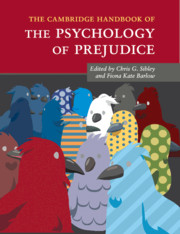Book contents
- Frontmatter
- Dedication
- Contents
- List of Figures
- List of Tables
- Notes on the Contributors
- Part I General Theoretical Perspectives
- Part II Prejudice in Specific Domains
- Part III Prejudice Reduction and Analysis in Applied Contexts
- 20 Recent Developments in Intergroup Contact Research: Affective Processes, Group Status, and Contact Valence
- 21 From Prejudice Reduction to Collective Action: Two Psychological Models of Social Change (and How to Reconcile Them)
- 22 Self-Regulation Strategies for Combatting Prejudice
- 23 Antecedents and Consequences of Evaluative Concerns Experienced During Intergroup Interaction: When and How Does Group Status Matter?
- 24 Stereotypicality Biases and the Criminal Justice System
- 25 Prejudice, Stigma, Bias, Discrimination, and Health
- 26 Development of Delegitimization and Animosity in the Context of Intractable Conflict
- 27 Interventions in Real-World Settings: Using Media to Overcome Prejudice and Promote Intergroup Reconciliation in Central Africa
- 28 Identification with All Humanity: The Antithesis of Prejudice, and More
- 29 It's All About Ignorance: Reflections from the Blue-eyed/Brown-eyed Exercise
- Index
- References
29 - It's All About Ignorance: Reflections from the Blue-eyed/Brown-eyed Exercise
from Part III - Prejudice Reduction and Analysis in Applied Contexts
Published online by Cambridge University Press: 17 November 2016
- Frontmatter
- Dedication
- Contents
- List of Figures
- List of Tables
- Notes on the Contributors
- Part I General Theoretical Perspectives
- Part II Prejudice in Specific Domains
- Part III Prejudice Reduction and Analysis in Applied Contexts
- 20 Recent Developments in Intergroup Contact Research: Affective Processes, Group Status, and Contact Valence
- 21 From Prejudice Reduction to Collective Action: Two Psychological Models of Social Change (and How to Reconcile Them)
- 22 Self-Regulation Strategies for Combatting Prejudice
- 23 Antecedents and Consequences of Evaluative Concerns Experienced During Intergroup Interaction: When and How Does Group Status Matter?
- 24 Stereotypicality Biases and the Criminal Justice System
- 25 Prejudice, Stigma, Bias, Discrimination, and Health
- 26 Development of Delegitimization and Animosity in the Context of Intractable Conflict
- 27 Interventions in Real-World Settings: Using Media to Overcome Prejudice and Promote Intergroup Reconciliation in Central Africa
- 28 Identification with All Humanity: The Antithesis of Prejudice, and More
- 29 It's All About Ignorance: Reflections from the Blue-eyed/Brown-eyed Exercise
- Index
- References
Summary
On Friday, April 5, 1968, I entered my third-grade classroom in Riceville, Iowa, determined to teach my students about the ugliness of prejudice and the discrimination that results from it. I had decided, while watching the news the night before, that the killing of Martin Luther King Jr., who had been one of our “Heroes of the Month” in February, could not go unnoticed by my students. Our lesson plan for the day, since we were involved in studying the Native American unit, was to learn the Sioux Indian prayer that says, “Oh, Great Spirit, keep me from ever judging a man until I have walked a mile in his moccasins.” I had decided that I would arrange to have that prayer answered for my students, on this fateful day, by treating them fairly or unfairly, based solely on the color of their eyes. I didn't create this exercise from nothing, you realize; I modeled it on what I learned in the third grade about Adolph Hitler sending people into gas chambers, based, in part, on the color of their eyes. By the end of the day, my students had learned more than I had ever taught them before, and I had learned more than they had.
The first thing I learned was that I didn't know anything about racism, its causes, and/or effects. I had always been taught, by the significant adults in my environment, that discrimination is caused by prejudice, that prejudice is the problem. All you have to do is change people's hearts and behavioral change will follow. I was certain that the same thing would happen with my students; so, after we had said the Pledge of Allegiance to the Flag and had sung “God Bless America,” we began to talk about the killing of Martin Luther King Jr. It was obvious that my students weren't internalizing anything that was being said; so I asked them whether they had any idea how it would feel to be treated as many people of color are treated in this country. Of course, they didn't, but they indicated that they'd like to try something that would help them know a little bit more than they knew about that situation.
- Type
- Chapter
- Information
- The Cambridge Handbook of the Psychology of Prejudice , pp. 655 - 668Publisher: Cambridge University PressPrint publication year: 2016
References
- 1
- Cited by



